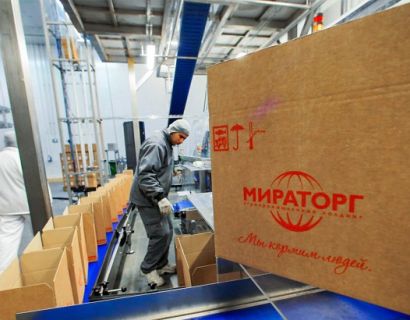Everything for  Business
Business
 Business
Business
 Business
Business
“Miratorg” brothers Linnikov in five years will invest 27.5 billion rubles. in the industrial production of lamb. Now restaurants prefer imported lamb, and retailers face a shortage of this packaged meat.

Igor Zarembo / RIA News. Agroholding Miratorg launches a project on industrial production of lamb meat.
“Miratorg” brothers Linnikov in five years will invest 27.5 billion rubles. in the industrial production of lamb. Now restaurants prefer imported lamb, and retailers face a shortage of this packaged meat.
The agricultural holding Miratorg is launching a project for the industrial production of lamb meat in Russia, company president Viktor Linnik told reporters. According to him, the project will become the largest lamb production in Russia: Miratorg plans to build 12 farms for 1.3 million heads per year, or 71.2 thousand tons of meat in live weight. Investments in the project will amount to more than 27.5 billion rubles. It will be implemented within four to five years.
The pilot farm, a breeding reproducer, is located in Kursk: in February of this year, 17 thousand sheep were brought from Australia. The first products will be sold in January-February, Linnik expects. The opening of two more farms is planned in the Tula region: an investment agreement on the establishment of sheep-breeding complexes was signed at the Golden Autumn exhibition, the investment will be about 6 billion rubles. The sites for the remaining nine farms have not yet been defined.The project provides for deep processing of products at a high-tech slaughterhouse. The planned production volume of finished products is 35 thousand tons of lamb meat per year, “about half will be exported,” Linnik said.
First in pigsMiratorg is included by the government in the list of strategic enterprises of Russia. The agricultural holding is the largest pork producer in the country with a market share of 10.9% from the end of 2017, Cherkizovo group cites data from the National Union of Pig Breeders. Miratorg itself reports that last year it produced 415 thousand tons of pork in live weight, 82 thousand tons of beef, 114 thousand tons of poultry meat.Financial indicators are not disclosed. The Miratorg statements only indicated that in 2017, the revenue under IFRS increased by 4.5%, to 112.9 billion rubles.The owners of the holding are the brothers Alexander and Victor Linniki. The status of each Forbes magazine in its latest rating “200 richest businessmen of Russia” is estimated at $ 600 million ( 168th and 169th places in the rating).
"A lot of the usual lamb"The volume of lamb production in Russia is an order of magnitude smaller than beef and pork, according to Rosstat data. According to his information , nearly 6.2 million tons of poultry meat was sold in 2017 in Russia, 4.2 million tons of pork, 2.2 million tonnes of beef and only 299 thousand. Tons of meat of sheep and goats (they are considered to be together). Mainly sheep and goats are raised in Dagestan - 21% of the total Russian population of these animals, or 5.7 million heads, are concentrated in the republicOfficial statistics do not take into account the volume of gray lamb production, and in reality this market can be much larger, warns the head of the executive committee of the National Meat Association, Sergey Yushin. Rosstat data may not be reliable, farmers produce a significant amount of lamb and sell it in local markets, agrees Musheg Mamikonyan, President of the Meat Union of Russia.
In Russia, “a lot of ordinary lamb” is produced, but there is no standard of production, guarantees of product safety and quality, and this is the “main problem”, Viktor Linnik complained in an interview with RBC in 2017. “Mutton from the Caucasus is brought to the central regions, where the word“ veterinary medicine ”is not perceived positively,” the Miratorg president noted.Unlike more developed pork or beef production, lamb production depends on the season (young lambs appear in summer, they are much smaller in winter) and cannot provide a uniform supply to retailers throughout the year, says Mamikonyan. According to him, consumers buy lamb mainly in the markets, the offer of products in the cut and packaged form is virtually absent. Retailers face a shortage of mutton in the package, and its prices are higher than other types of meat, Yushin said. In X5 Retail Group, “Magnite”, “Auchan”, “Lente”, “Dixie”, “Okay” did not respond to requests.In September, lamb, according to Rosstat, was worth 368.1 rubles in retail. for 1 kg, while pork and beef (except for boneless meat) - respectively 273.4 and 325.9 rubles. for 1 kg.For restaurants, lamb, like beef, is a traditional type of meat, said Igor Bukharov, president of the Federation of Restaurateurs and Hoteliers. But in restaurants now mainly imported lamb is represented, mainly from Latin America. In 2017, according to the Federal Customs Service, Russia imported 3.2 thousand tons of mutton for $ 16.8 million rubles. Imports are in demand, because domestic lamb is not cooked up like imported ones, “when portions of meat sealed in a vacuum come to the restaurant,” explains Bukharov.The Miratorg project will contribute to the formation of this market on a different, larger scale, Mamikonyan believes. He estimates the export potential of Russia at 20–30 thousand tons of mutton per year. But with current production volumes and in the absence of standards, such deliveries are possible only to the less organized markets of Central Asia, the categorical expert. In Miratorg, the Persian Gulf countries, China and Japan are potential lamb export markets. But for this to be certified, adds Linnik.
rbc.ru
 As the U.S. IPO market languishes, listings head east to booming China.
As the U.S. IPO market languishes, listings head east to booming China.
 Pound sterling rises as traders ponder the agenda of new British Prime Minister Truss
Pound sterling rises as traders ponder the agenda of new British Prime Minister Truss
 Central Banks in Jackson Hole Take Tougher Mission Ahead
Central Banks in Jackson Hole Take Tougher Mission Ahead
 Bitcoin continues to retreat as the 200-week average focuses again
Bitcoin continues to retreat as the 200-week average focuses again
 Private investors buy up retail real estate as major players remain cautious
Private investors buy up retail real estate as major players remain cautious
This site uses cookies and other visitor identifiers for the convenience of each user. If you stay on our site after reading this message, it means that you have no objection to the use of these technologies. Learn more
